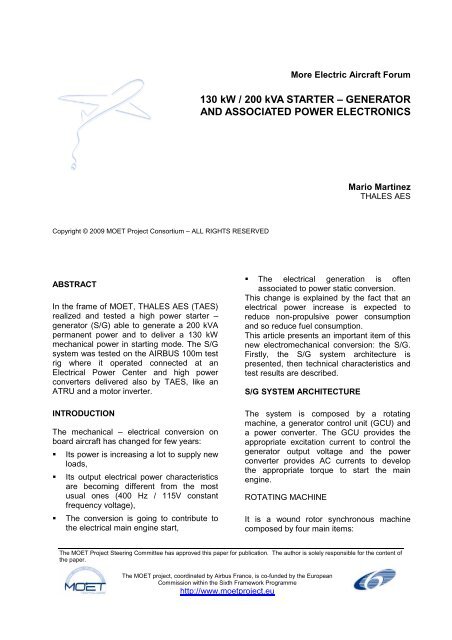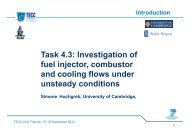130 kW / 200 kVA STARTER
130 kW / 200 kVA STARTER
130 kW / 200 kVA STARTER
Create successful ePaper yourself
Turn your PDF publications into a flip-book with our unique Google optimized e-Paper software.
Copyright © <strong>200</strong>9 MOET Project Consortium – ALL RIGHTS RESERVED<br />
ABSTRACT<br />
In the frame of MOET, THALES AES (TAES)<br />
realized and tested a high power starter –<br />
generator (S/G) able to generate a <strong>200</strong> <strong>kVA</strong><br />
permanent power and to deliver a <strong>130</strong> <strong>kW</strong><br />
mechanical power in starting mode. The S/G<br />
system was tested on the AIRBUS 100m test<br />
rig where it operated connected at an<br />
Electrical Power Center and high power<br />
converters delivered also by TAES, like an<br />
ATRU and a motor inverter.<br />
INTRODUCTION<br />
The mechanical – electrical conversion on<br />
board aircraft has changed for few years:<br />
Its power is increasing a lot to supply new<br />
loads,<br />
Its output electrical power characteristics<br />
are becoming different from the most<br />
usual ones (400 Hz / 115V constant<br />
frequency voltage),<br />
The conversion is going to contribute to<br />
the electrical main engine start,<br />
The MOET Project Steering Committee has approved this paper for publication. The author is solely responsible for the content of<br />
the paper.<br />
The MOET project, coordinated by Airbus France, is co-funded by the European<br />
Commission within the Sixth Framework Programme<br />
http://www.moetproject.eu<br />
More Electric Aircraft Forum<br />
<strong>130</strong> <strong>kW</strong> / <strong>200</strong> <strong>kVA</strong> <strong>STARTER</strong> – GENERATOR<br />
AND ASSOCIATED POWER ELECTRONICS<br />
Mario Martinez<br />
THALES AES<br />
The electrical generation is often<br />
associated to power static conversion.<br />
This change is explained by the fact that an<br />
electrical power increase is expected to<br />
reduce non-propulsive power consumption<br />
and so reduce fuel consumption.<br />
This article presents an important item of this<br />
new electromechanical conversion: the S/G.<br />
Firstly, the S/G system architecture is<br />
presented, then technical characteristics and<br />
test results are described.<br />
S/G SYSTEM ARCHITECTURE<br />
The system is composed by a rotating<br />
machine, a generator control unit (GCU) and<br />
a power converter. The GCU provides the<br />
appropriate excitation current to control the<br />
generator output voltage and the power<br />
converter provides AC currents to develop<br />
the appropriate torque to start the main<br />
engine.<br />
ROTATING MACHINE<br />
It is a wound rotor synchronous machine<br />
composed by four main items:
PMG (Permanent Magnet Generator):<br />
included auxiliary alternator, which supplies<br />
the GCU in generating mode;<br />
ME (Main Exciter): included auxiliary wound<br />
field alternator supplied by the GCU in<br />
generating mode and supplied by an inverter<br />
in starting mode;<br />
RR (Rotating Rectifier): supplied by the<br />
rotating ME winding, it supplies the MSG<br />
(Main Starter Generator) field winding;<br />
MSG (Main Starter Generator): wound field<br />
alternator which provides voltage controlled<br />
electrical power in generating mode and<br />
which is supplied by a current controlled<br />
power inverter in starting mode.<br />
fig.1 - rotating machine scheme<br />
fig.2 - rotating machine on TAES rig<br />
POWER CONVERTER<br />
It includes an input filter stage, an output filter<br />
stage and three inverters. Two of them are<br />
paralleled to supply the MSG winding. Their<br />
switching frequencies are interleaved to<br />
decrease the DC input filter size and AC<br />
Copyright © <strong>200</strong>9 MOET Project Consortium – ALL RIGHTS RESERVED<br />
Page 2 of 4<br />
current ripples inside the MSG winding. The<br />
third one supplies the ME winding. It is only<br />
used in starting mode.<br />
+/-270V DC<br />
Electric starter power converter<br />
DC input<br />
filter<br />
75 <strong>kW</strong> inverter<br />
module<br />
75 <strong>kW</strong> inverter<br />
module<br />
Main exciter<br />
inverter<br />
Common<br />
AC<br />
output<br />
filter<br />
AC output<br />
filter<br />
fig.3 - power converter scheme<br />
3<br />
Wound Field<br />
Starter Generator<br />
Exciter<br />
fig.4 - power converter during TAES tests<br />
MAIN CHARATERISTICS<br />
ROTATING MACHINE<br />
Starter power: <strong>130</strong> <strong>kW</strong>,<br />
Starter maximum torque: 300 N.m,<br />
Rated generator power: <strong>200</strong> <strong>kVA</strong>,<br />
Output voltage: 230 VAC,<br />
Generator speed range: 7600–16000rpm,<br />
Frequency range: 380-800 Hz,<br />
Cooling: oil circulation and oil spray.<br />
POWER CONVERTER<br />
Input voltage: 540 VDC,<br />
Output power: 150 <strong>kW</strong>,<br />
Output current: 300 ARMS,<br />
Cooling: oil circulation.
TEST RESULTS<br />
STARTING MODE<br />
Different torque-speed characteristics were<br />
tested. Fig.5 shows one of them:<br />
N.m<br />
300<br />
250<br />
<strong>200</strong><br />
150<br />
100<br />
50<br />
0<br />
0 1000 <strong>200</strong>0 3000 4000 5000 6000 7000 8000<br />
tr/min<br />
Couple gabarit<br />
fig.5 - measured torque versus speed<br />
compared to expected curve<br />
Three successive starts were performed at<br />
low cooling oil flow, to check the maximum<br />
temperature inside the machine at the end of<br />
the test. End winding temperatures remained<br />
at a low level (150°C like fig.6 indicates it).<br />
160,00<br />
140,00<br />
120,00<br />
100,00<br />
80,00<br />
60,00<br />
40,00<br />
20,00<br />
Cycle de démarrage avec débit de 2400 tr/min<br />
0,00<br />
0,00 100,00 <strong>200</strong>,00 300,00 400,00 500,00 600,00<br />
TS2 TB AV TS3 TB AV TS4 TB AR TS5 TB AR TS6 TB AR TS7 Encoche TS8 Encoche TS9 Encoche<br />
fig.6 - winding temperatures measured during<br />
three successive starts at low oil flow<br />
In addition temperatures were measured<br />
inside the power converter during six<br />
successive starts. IGBT base plate<br />
temperatures remained below 70°C.<br />
Copyright © <strong>200</strong>9 MOET Project Consortium – ALL RIGHTS RESERVED<br />
Page 3 of 4<br />
fig.7 - converter temperatures measured<br />
during six successive starts<br />
GENERATING MODE<br />
The S/G was associated to the GCU.<br />
The S/G delivered the expected power at the<br />
controlled 230VAC voltage.<br />
Main characteristics measured in generating<br />
mode are summarized hereafter:<br />
Speed range: 7600 to 16000 rpm,<br />
Permanent output power: <strong>200</strong> <strong>kVA</strong>,<br />
5 min output power: 240 <strong>kVA</strong>,<br />
5 sec output power: 320 <strong>kVA</strong>,<br />
Power factor: 0.75 to 1,<br />
Three phase phase to neutral voltage:<br />
230 VRMS.<br />
Power transients were tested. Transients no<br />
load / <strong>200</strong> <strong>kVA</strong> and <strong>200</strong> <strong>kVA</strong> / no load are<br />
shown in fig.8:<br />
fig.8 - output voltage variation during no<br />
load/load and load/no load transients
CONCLUSION<br />
The <strong>130</strong> <strong>kW</strong> / <strong>200</strong> <strong>kVA</strong> starter – generator<br />
was tested successfully on TAES rig. Then it<br />
was integrated on the AIRBUS test bench<br />
and connected to several power converters<br />
via an AC Power Center and a DC Power<br />
Center. Tests were conducted to estimate the<br />
network stability and the power quality. In<br />
general, test results showed the system<br />
functionality. It will be the basis for the further<br />
starter – generator developments during<br />
which mass, efficiency and compatibility with<br />
the new electrical networks will be optimized.<br />
ACKNOWLEDGMENTS<br />
The MOET project is a European Project, cofunded<br />
by the European Commission within<br />
the Sixth Framework Programme.<br />
CONTACT<br />
Mario Martinez<br />
TAES technical contact in MOET project<br />
Email address:<br />
mario.martinez@fr.thalesgroup.com<br />
Copyright © <strong>200</strong>9 MOET Project Consortium – ALL RIGHTS RESERVED<br />
Page 4 of 4<br />
DEFINITIONS, ACRONYMS,<br />
ABBREVIATIONS<br />
GCU : Generator Control Unit<br />
IGBT : Insulated Gate Bipolar<br />
Transistor<br />
ME Main Exciter<br />
MSG Main Starter Generator<br />
PMG Permanent Magnet<br />
Generator<br />
RR Rotating Rectifier<br />
S/G : Starter - generator<br />
TAES : THALES AES















